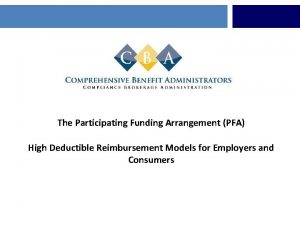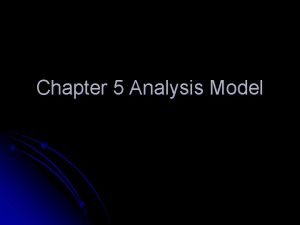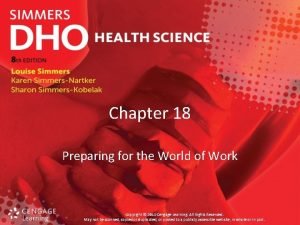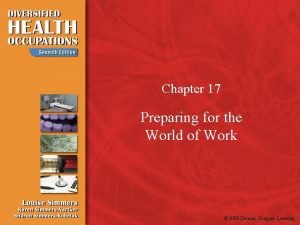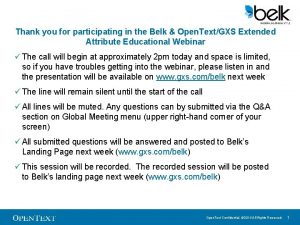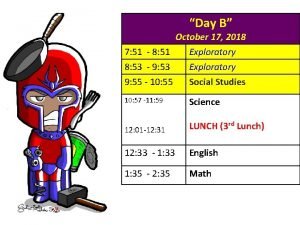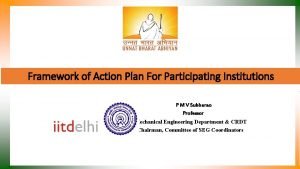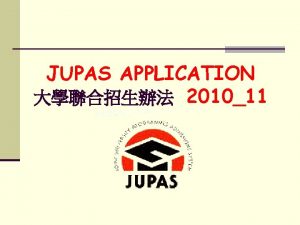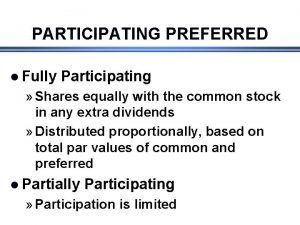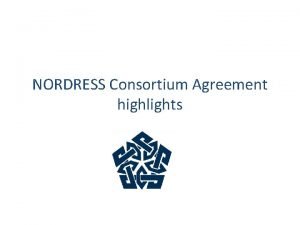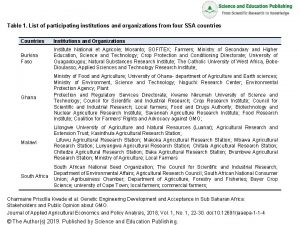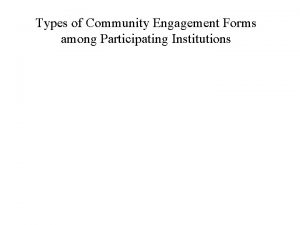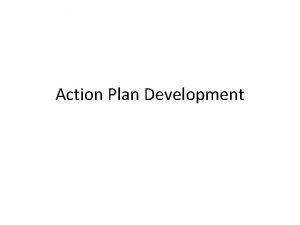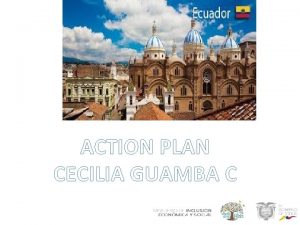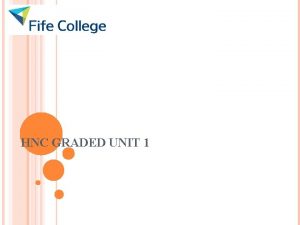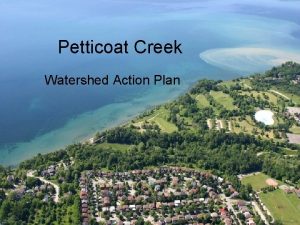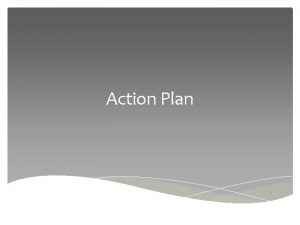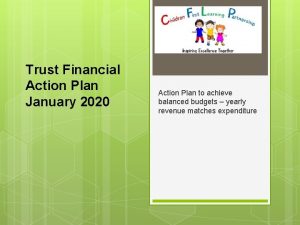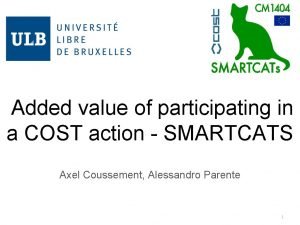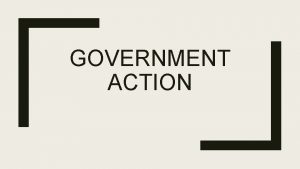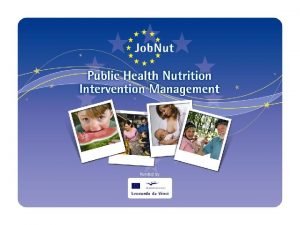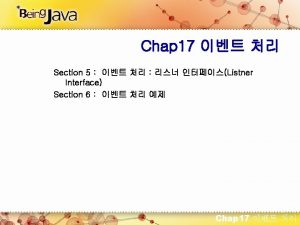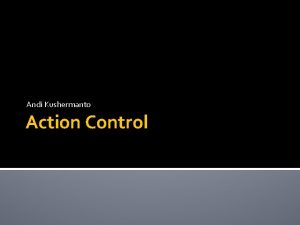Framework of Action Plan For Participating Institutions P



























































- Slides: 59

Framework of Action Plan For Participating Institutions P M V Subbarao Professor Mechanical Engineering Department & CRDT Chairman, Committee of SEG Coordinators

Objective of this Activity • To Suggest Steps/Guidelines to the PIs formulating plan of action for Village Development

My First Exposure to Work for Rural Areas Shri Mangal Singh Water Wheel on River Sajnam, Bhailoni Lod Village Lalitpur Dist.

Highly Useful Non-scientific Innovation

First Level Insitu Analysis of the Mangal Turbine by me • • • Diameter of the wheel : 4 m. 24 blades ! Huge Diameter ! Weighing more than a ton! Huge material cost! Speed of the wheel: 13 RPM. Very Low Speed! The speed of A common pump or Generator is 1500 RPM. A gear box is required to Increase the speed 120 times! Very costly gear box.

Comparative Study of Original Design and that of R&D

Design II : Krishi Vigyan Kendra , Jagdishpur, Sonipat 5 KW design with 3. 7 KW Irrigation Pump

Comparative study on development of Micro hydro water wheel Specification Diameter in m Farmer ’s version Bhailoni Village Lalitpur, UP New Design I (Semera Village) Lalitpur, UP New Design II (KVK, Sonipat) Haryana 4 1. 26 1. 5 Head at site in m 1. 5 1 Power developed 6 kw 5 kw Water utilized to run Pump discharge 1800 l/s 450 l/s 22 l/s 40%[t] 20%[p] 72%[t] 68%[p] 86%[t] 76%[p] 24 14 15 Principle impulse Cost of wheel $1800 $160 $170 Cost of gear box $2700 $320 $400 Efficiency No. of blades

Minimal Civil Construction Layout


A Geometrical Model of the Concept d Rp Re w 2 j 1 D dj, Vj 1 A 1 B 1 C

Computational Domain F E D Half Width A B 1 m C





Results for the stationary bucket analysis

Effect of variation of U/V ratio

Design of Blade B 2 T Do

CAD Model of Final Wheel

HEIs can Make a Difference!!!!

Vertical Axis Water Wheels A Source of power in Rural Uttaranchal

Site visited Head available (in M) Flow Rate (l/sec) Wheel Speed In RPM Output Speed In RPM Diameter of wheel In CM No. of Blades Power Output In KW Applications Sangtiyawala 1. 40 480 90 1500 106 16 1 Chakki, Alternator Bhogpur Gharat (1) 2. 30 889 95 1500 106 16 2 Dhan Cutter, Alternator Bhogpur Gharat (2) 2. 30 645 104 84 29 - Chakki Donkwala (1) 1. 50 - 70 1500 100 30 1 Chakki, Alternator Donkwala (2) 1. 50 - 90 1500 97 30 1 Chakki, Alternator Donkwala (3) 1. 25 - 95 1500 90 29 1 Chakki, Alternator Naya Gharat , Lacchiwala 1. 85 634 50 1500 107 11 5 Chakki, Dhan cutter, Alternator Unnat Gharat 0. 6 352 100 90 29 - Chakki New Design 1. 8 + 1. 0 342 100 1500 73 11 3 Chakki, Alternator

Suggested layouts for Uttaranchal Units Generator Gear Box Main Shaft Canal Forbay Grinding Wheel Bush Bearing 12” Pulley 10” Pulley Penstock Water Wheel New Design Wooden Base Grinder adjusting lever

Specification of upgraded wheel for Garwhal area

National Workshop on Development of Man-Power in Ultra Micro Hydel Turbines for Rural Energy Systems 20 th March to 28 th March 2004.

My Direct Contributions v. Design, Fabrication and Erection of 5 k. W Horizontal Axis Hydro-Turbo Pump on a small river near Jhansi. v. Design , Fabrication and Testing of 3. 5 k. W Horizontal Axis Hydro-Turbo Pump cum Generator on a Drainage Canal at Sonipat. v. Design, Fabrication of 3. 5 k. W Vertical Axis Hydro-Turbo Atta Chakki cum Alternator at Lacchiwala, near Dehradun. v. Design and Development of 5 KW Horizontal Axis Hydro-Turbo Pump cum Generator at Pokhri, Uttaranchal. v. Design and Development of 5 KW Horizontal Axis Hydro Generator at Halflong, Assam.

Strategy to work in/work for Rural Areas • Selection of Village • Awareness and Participation • Need Analysis • Planning • Project Formulation • Implementation • Monitoring and Assessment • Evaluation

Selection of Villages • Closeness to the institute • Backwardness of Village • Any Prior linkage of institute

Establishing Contact, Awareness, and Participation • Meeting with Panchayat Secretary, Gram Pradhan, BDPO, JE • Meeting with elders, youth groups, Women groups • Identifying one problem and provide immediate solution

Awareness and Participation • Engage the faculty members • NSS and Student volunteers • Student Clubs (film society, dramatics, fine arts, etc. ) • Field Agencies and Organizations • Institutes in the neighbourhood

Situation Analysis and Need Identification • Baseline Study • Village level survey • Household survey • Census Data, NSSO data • Identification of Key Issues • Participatory Planning People’s priority Local Solutions Selection of interventions

Analysis through Survey • DEMOGRAPHIC PROFILE Gender Age Group Poverty Linking with Govt Schemes LAND AGRICULTURE RESOURCES Land use pattern Irrigation Forest and Horticulture Use of Chemicals Livestock status • BASIC AMENITIES Education Health Drinking Water Drainage and Sanitation SLWM ENERGY AND POWER Lighting source Cooking Fuel

Gaindikhata

Project Formulation 1. Technology identification and Proposing Solution Validation through experts-SEG Cost Estimation Identification of schemes People’s Feedback 2. Discussion with District Agencies 3. Funding and Convergence 4. Implementation of the Solutions

Monitoring, Assessment and Evaluation • Setting up of Measurable Targets • Documentation of all the experiences • Periodic Assessment of set targets

Long Term Action Plan for Village Development • Plan for holistic & integrated village development Social Development Economic development Infrastructure development Human development • Provide support in implementation of Government Projects • Participation in DISHA • Monitoring and evaluation of the projects Helping Panchayats through technical support/technical experts Helping in preparing the monitoring and evaluation report Helping in Impact Assessment

National Level Monitoring • Web based system • Every activity to be documented and made available in public domain • The outputs under each activity would be measured every quarter in relation to the physical and financial targets

Tentative time line Item of Work Time From Selection of Villages (In Months) Selection of the cluster - Awareness generation Two Social mobilisation Two Baseline survey Two Situation analysis Two-Four Action Plan (Project Formulation, mapping with schemes, departments) Three-Seven Approval and sanctions Four-Eight Implementation in the field After Five Months Progress review one

CASE STUDY “Off-grid Electrification of Village Khaira Begi District -Chatra, Jharkhand, India”.

Village Khaira Begi District -Chatra, Jharkhand, India”.

VILLAGE AT A GLANCE Economy of the village is mainly depended on the agricultural activities. Paddy is main crop of this village.

Plant Layout

PROJECT BRIEF • Installation of a 5. 80 k. Wp stand alone Solar PV Plant • 20 k. Wh Panasonic make Lithium Ion battery for energy storage. • Mini Grid has been installed in the villages and each household are through localized distribution line. • During the day time, surplus power will be utilized to run productive load such as rice huller and solar water pumps. • Each house is having a provision of Lighting, Fan and Mobile charging.

Project Summary

Tariff Fixation and Revenue Collection • Based on the preliminary interaction, it was found that villagers are willing to pay for the use of power supplied by solar mini grid. • A fixed tariff of 100 Rs. /Months for domestic use • A tariff of 150 Rs. /Month for livelihood useslike pump and rice huller. • A village energy committee has been constituted a five members including 2 Male and 3 Female. • To monitor/manage the operational and financial issues. • Village energy committee will also circulate the annual income to all household so that every consumer can know the financial status.

Present Status

Measureable Impacts

Participatory Planning Process Dr. Vivek Kumar Associate Professor CRDT, IIT Delhi

Planning and Village Development Planning is the process of systematically finding the best ways to solve a problem, achieve some desired goal or create some required object. Village Development Planning is Steps in planning: • identifying problems and finding ways to • Identifying the problems, solve them, • ways to solve the problems, • identifying future desired goals • most suitable solutions, • finding ways to achieve development through a systematic process. • detailing the solution or the • All groups of people included and the project, needs of poor households, SC and ST • Implementing the project groups, women, children and the elderly and managing it. taken into account.

Implementation is getting things done as planned. Steps in implementation: • Develop an implementation plan, • Organize the resources, • Get it done! • Ensure proper procedures for creating and managing

Review the issues & identify the problems/needs Identify pressing problem(s) faced by all Identification of key issues by analysis of collected information 1 st round of mobilization, planning, and discussion and get support to develop the next three steps Enlist all the items needed for data collection Organization of system and people for village-wide data collection Preparation of Panchayat database with system for recording, arranging, storing, updating and retrieving Selection of most suitable and widely acceptable alternative solutions Detail the solution – the program or project (design, technical support, funds and other resources required) Decide the plan for doing the project – how it will be done, who will do it, etc. Implementing the project or program! (Monitoring and trouble-shooting) Decide the management system and rules for operation and management of the project. Village meetings to discuss the problems, solutions, implementation and management Ensure widespread participation of villagers in decision making, implementation and management through resident committees, etc. Establishment of systems and practices for transparent and accountable functioning by involving all groups. Sustain participatory planning and development management in village. 3. PARTICIPATORY PLANNING & MANAGEMENT Tools for quick collection of information 2. GETTING PARTICIPATION & SUSTAINING IT 1. PREPARING A VILLAGE DATABASE Processing & Analysis of Information

Participatory Rural Appraisal (PRA): “For the Rural community, by the Rural community and with the Rural Community”. It is a process to involve the community in planning and decision making. Community develop their won skills needed to address issues, analyze options and carry out activities. Participatory decision making reflects respect for human dignity and creating the opportunity for individuals to fulfill their responsibility to exercise the right.

Principles of PRA Level - 1 Reversal of learning To learn from the local people Learning rapidly and progressively Exploration, flexible methods, adaptable Offsetting bias To be receptive rather than preconceived ideas Optimizing tradeoffs Understanding the usefulness of information Triangulating Crosschecking and approximation

Principles of PRA Level - 2 Empowerment The authority to local people through decentralization and confidence building Self critical awareness Mistakes are lessons to learn and to do better next time Personal responsibility The belongingness and ownership to the participants Sharing To discuss and argue about ideas in open forum with all stakeholders

Ethos

TYPES OF PRA METHODS SPACE MAPPING PRA METHODS TIME MAPPING RELATION METHODS • • • Social and Resource map Participatory Modeling Method Mobility map Services and Opportunities map Transect Participatory Census Method • • Timeline Trend Analysis Historical transect Seasonal Diagram • Social Effects, Impact, system, network Diagram, Process Map, Well Being, Ranking, Venn Diagram, Pair-wise ranking, Matrix ranking, Pie, Livelihood analysis, Spider Diagram, body Mapping

Planning Perspective Surveys Transect Walk Gram Sabha Situation Analysis Need Analysis Plan of Action. Implementable Projects Mapping and Triangulation Comprehensive Development Plan

Thank You
 Participating funding arrangement
Participating funding arrangement View of participating classes
View of participating classes Chapter 18:3 completing job application forms
Chapter 18:3 completing job application forms Chapter 17:4 participating in a job interview
Chapter 17:4 participating in a job interview Thank you for participating images
Thank you for participating images Situational leadership
Situational leadership While shopping kyla found a dress
While shopping kyla found a dress Participating contracts
Participating contracts Formuö
Formuö Typiska drag för en novell
Typiska drag för en novell Nationell inriktning för artificiell intelligens
Nationell inriktning för artificiell intelligens Returpilarna
Returpilarna Shingelfrisyren
Shingelfrisyren En lathund för arbete med kontinuitetshantering
En lathund för arbete med kontinuitetshantering Underlag för särskild löneskatt på pensionskostnader
Underlag för särskild löneskatt på pensionskostnader Tidbok yrkesförare
Tidbok yrkesförare Sura för anatom
Sura för anatom Förklara densitet för barn
Förklara densitet för barn Datorkunskap för nybörjare
Datorkunskap för nybörjare Boverket ka
Boverket ka Mall för debattartikel
Mall för debattartikel Autokratiskt ledarskap
Autokratiskt ledarskap Nyckelkompetenser för livslångt lärande
Nyckelkompetenser för livslångt lärande Påbyggnader för flakfordon
Påbyggnader för flakfordon Lufttryck formel
Lufttryck formel Svenskt ramverk för digital samverkan
Svenskt ramverk för digital samverkan Kyssande vind analys
Kyssande vind analys Presentera för publik crossboss
Presentera för publik crossboss Vad är ett minoritetsspråk
Vad är ett minoritetsspråk Bat mitza
Bat mitza Klassificeringsstruktur för kommunala verksamheter
Klassificeringsstruktur för kommunala verksamheter Mjälthilus
Mjälthilus Claes martinsson
Claes martinsson Centrum för kunskap och säkerhet
Centrum för kunskap och säkerhet Byggprocessen steg för steg
Byggprocessen steg för steg Bra mat för unga idrottare
Bra mat för unga idrottare Verktyg för automatisering av utbetalningar
Verktyg för automatisering av utbetalningar Rutin för avvikelsehantering
Rutin för avvikelsehantering Smärtskolan kunskap för livet
Smärtskolan kunskap för livet Ministerstyre för och nackdelar
Ministerstyre för och nackdelar Tack för att ni har lyssnat
Tack för att ni har lyssnat Mall för referat
Mall för referat Redogör för vad psykologi är
Redogör för vad psykologi är Borstål, egenskaper
Borstål, egenskaper Tack för att ni har lyssnat
Tack för att ni har lyssnat Borra hål för knoppar
Borra hål för knoppar Orubbliga rättigheter
Orubbliga rättigheter Standardavvikelse formel
Standardavvikelse formel Tack för att ni har lyssnat
Tack för att ni har lyssnat Rita perspektiv
Rita perspektiv Verksamhetsanalys exempel
Verksamhetsanalys exempel Tobinskatten för och nackdelar
Tobinskatten för och nackdelar Blomman för dagen drog
Blomman för dagen drog Modell för handledningsprocess
Modell för handledningsprocess Egg för emanuel
Egg för emanuel Elektronik för barn
Elektronik för barn Plagg i rom
Plagg i rom Strategi för svensk viltförvaltning
Strategi för svensk viltförvaltning Kung som dog 1611
Kung som dog 1611 Humanitr
Humanitr
